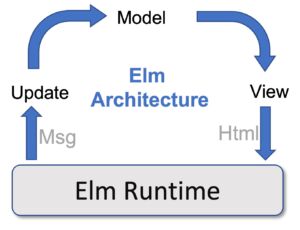This is the first in the series for Elm programming Language.
In this part, we would cover the following
- Overview of Elm Programming Language
- Features of Elm
- The Elm Architecture
- Benefits of Elm Programming
- Application Areas of Elm
- How to Learn Elm
1. Overview of Elm Programming Language
Elm is a pure functional programming Language and is developed with focus on performance, usability and robustness. It is also described as a domain-specific language (DSL). This means that it specalized to a particular application domain. This is in contrast with general-purpose languages which have a wide range of application domains.
Elm can be used for declaratively creating web browser-based GUI applications.
2. Features of Elm
Some of the features of Elm programming language includes the following:
Static Typing – Elm is a statically typed language. Type annotations can be used as well. Though they are optional, they are encouraged.
No Runtime Exceptions – This a promise as well as a feature and this is made possible by static typing feature of Elm. All potential errors are validated and fixed at compile time.
Immutability – Values in an Elm program are immutable. This means that they cannot later be modified after they have been created. Arrays, Sets and Dictionaries are implemented in Elm using persistent data structures.
Module System – Elm uses a modular system and this makes it possible to break the codes into smaller parts called modules. This allows you to hide implementation details using helper function and also group related codes together.
Can Integrated with HTML, CSS and JS – A feature in Elm called ports allow your Elm program to communicate with javaScript. Also, the elm/html library in Elm allows you to write HTML and CSS codes within Elm. Finally just like React, Elm uses virtual DOM to make updates more efficient.
Backend – Although Elm does not natively support server-side development, some independent project are available for exploring this possibility.
3. The Elm Architecture
It’s necessary you understand the Elm architecture as this is what distinguishes it from other programming languages.
And Elm program has three parts:
- Model – this is the state of the application
- View – a function that transforms the model into HTML
- Update – a function that updates the model based on messages
This means that to update the state, you must send a message to the update function

Form the figure, you can see a loop that represents the Elm architecture. This means that once the Elm program is initialized, the execution continues in a repeated loop, taking actions form the user, changing the application state and representing the changes in HTML using a view.
4. Benefits of Elm Programming
Why should you learn Elm Programming Language? Here are some of the benefits:
Developer-friendly Error messages – The Elm compiler is designed to provide very informative and specific developer-friendly error messages. These messages are emitted at compile time and can help easily fix any bug.
Reusable Code – Since Elm is a pure functional programming language, the functions can always be reused easily
No Runtime Exceptions – this has been explained earlier as errors are detected at compile time.
Other benefits includes, easy to test and automatic semantic versioning
5. Application Areas of Elm
Some of the things you can do with Elm includes:
- Building Interactive Games
- Building Rich Graphical Application
- Single Page Applications (SPA)
6. How to Learn Elm
The method that worked for me is a combination of both the tutorials, practicals and the videos. This very tutorial provides you systematic way to learn Elm from beginner to expert level. So I recommend you follow the lessons step by step without skipping any lesson.
Also find the video lessons available here in my YouTube Channel.